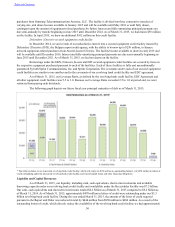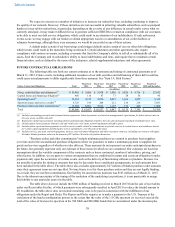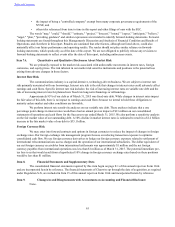Sprint - Nextel 2014 Annual Report Download - page 63
Download and view the complete annual report
Please find page 63 of the 2014 Sprint - Nextel annual report below. You can navigate through the pages in the report by either clicking on the pages listed below, or by using the keyword search tool below to find specific information within the annual report.
Table of Contents
61
Since the SoftBank Merger Date, actual results and expectations of net postpaid handset subscriber additions have
been lower than the forecasts used to allocate the purchase price to the assets acquired and liabilities assumed. During the
quarter ended December 31, 2014, the stock price and our related market capitalization decreased significantly and our credit
rating was downgraded by one of the ratings service providers. We also updated our long-term forecasted cash flows for the
Company and the Wireless reporting unit during the fourth quarter. This update considered current economic conditions and
trends, estimated future operating results, our views of growth rates, anticipated future economic and regulatory conditions,
future cost savings initiatives and the availability of the necessary network infrastructure, handsets and other devices. Based
on these events and changes in circumstances, we determined that recoverability of the carrying amount of goodwill and the
Sprint trade name should be evaluated for impairment during the quarter ended December 31, 2014.
The impairment test for an indefinite-lived intangible asset consists of a comparison of the fair value of the asset
to its carrying amount. If the carrying amount exceeds its fair value, an impairment loss is recognized equal to that excess.
We estimated the fair value of the Sprint trade name assigned to the Wireless segment using the relief-from-royalty method,
which uses several significant assumptions, including management projections of future revenue, a royalty rate, a long-term
growth rate and a discount rate. As these assumptions are largely unobservable, the estimate of fair value is considered to be
unobservable within the fair value hierarchy. The significant unobservable inputs included projected revenues, a royalty rate,
a growth rate of 1.5% in the terminal year and a discount rate of 16%. As of our testing date, carrying value of the Sprint
trade name exceeded its estimated fair value of $3.3 billion. Accordingly, during the quarter ended December 31, 2014 we
recorded an impairment loss of $1.9 billion, which is included in "Impairments" in our consolidated statements of operations.
Changes in certain assumptions can have a significant effect on the estimated fair value, specifically the royalty rate and the
discount rate. A 50 basis point decrease to the royalty rate would have resulted in an additional impairment of approximately
$600 million and an increase in the discount rate of 50 basis points would have resulted in an additional impairment of
approximately $100 million.
The analysis of potential impairment of goodwill requires a two-step approach. The first step of the goodwill
impairment test, used to identify potential impairment, compares the fair value of a reporting unit with its carrying amount,
including goodwill. We estimated the fair value of the Wireless reporting unit using both discounted cash flow and market
based valuation models. The determination of the fair value of the reporting unit requires significant estimates and
assumptions, including significant unobservable inputs. The key inputs included, but were not limited to, a discount rate of
8%, a terminal growth rate of 1.5%, a control premium, market multiple data from selected guideline public companies,
management’s internal forecasts which include numerous assumptions such as share of industry gross additions, churn, mix
of plans, rate changes, expenses, EBITDA margins, and capital expenditures, among others. We compared the estimated fair
value as of our testing date to the carrying amount of the Wireless reporting unit and concluded that the second step of a
goodwill impairment test was not required because the estimated fair value exceeded the carrying amount. Changes in certain
assumptions could have a significant impact to the estimated fair value of the Wireless reporting unit. For instance, a 20 basis
point increase to the discount rate would have resulted in a fair value for the Wireless reporting unit below its carrying value,
which would have resulted in the Company performing the second step of the goodwill impairment test, which could have
resulted in a goodwill impairment during the quarter ended December 31, 2014.
The determination of fair value requires considerable judgment and is highly sensitive to changes in underlying
assumptions. Consequently, there can be no assurance that the estimates and assumptions made for the purposes of the
goodwill and Sprint trade name impairment tests will prove to be an accurate prediction of the future. Continued, sustained
declines in the Company’s operating results, future forecasted cash flows, growth rates and other assumptions, as well as
significant, sustained declines in the Company’s stock price and related market capitalization could impact the underlying
key assumptions and our estimated fair values, potentially leading to a future material impairment of goodwill or other
indefinite-lived intangible assets.
Guarantee Liabilities
Under certain of our wireless service plans, we offer an option to our subscribers to purchase, on a monthly basis,
an annual trade-in right (the option). At the trade-in date, a subscriber, who has elected to purchase a device in an installment
billing arrangement, will receive a credit in the amount of the outstanding balance of the installment contract provided the
subscriber trades-in an eligible used device in good working condition and purchases a new device from Sprint. Additionally,
the subscriber must have purchased the option for the twelve consecutive months preceding the trade-in. When a subscriber
elects the option, the total estimated arrangement proceeds associated with the subscriber are reduced by the estimated fair
value of the fixed-price trade-in credit (guarantee liability) and the remaining proceeds are allocated amongst the other
deliverables in the arrangement. The guarantee liability is estimated based on assumptions, including, but not limited to, the
expected fair value of the used device at trade-in, subscribers’ estimated remaining balance of the remaining installment
























